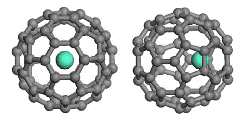Chemistry, Department of: Faculty Series

Xiao Cheng Zeng Publications
Document Type
Article
Date of this Version
1-2016
Citation
Published in Journal of the American Chemical Society 138 (2016), pp 1816−1819. doi 10.1021/jacs.5b13048
Abstract
In the atmosphere, a well-known and conventional pathway toward the formation of ammonium sulfate is through the neutralization of sulfuric acid with ammonia (NH3) in water droplets. Here, we present direct ab initio molecular dynamics simulation evidence of the formation of ammonium bisulfate (NH4HSO4) from the hydrated NH3 and SO3 molecules in a water trimer as well as on the surface of a water droplet. This reaction suggests a new mechanism for the formation of ammonium sulfate in the atmosphere, especially when the concentration of NH3 is high (e.g., ∼10 μg m−3) in the air. Contrary to the water monomer and dimer, the water trimer enables near-barrierless proton transfer via the formation of a unique loop structure around the reaction center. The formation of the loop structure promotes the splitting of a water molecule in the proton-transfer center, resulting in the generation a NH4+/HSO4− ion pair. The loop-structure promoted proton-transfer mechanism is expected to be ubiquitous on the surface of cloud droplets with adsorbed NH3 and SO3 molecules and, thus, may play an important role in the nucleation of aerosol particles (e.g., fine particles PM2.5) in water droplets.
Movie S2.mpg (14682 kB)
Movie S3.mpg (4080 kB)
Movie S4.mpg (858 kB)
Movie S5.mpg (1622 kB)
Movie S6.mpg (15092 kB)


Comments
Copyright © 2016 American Chemical Society. Used by permission.